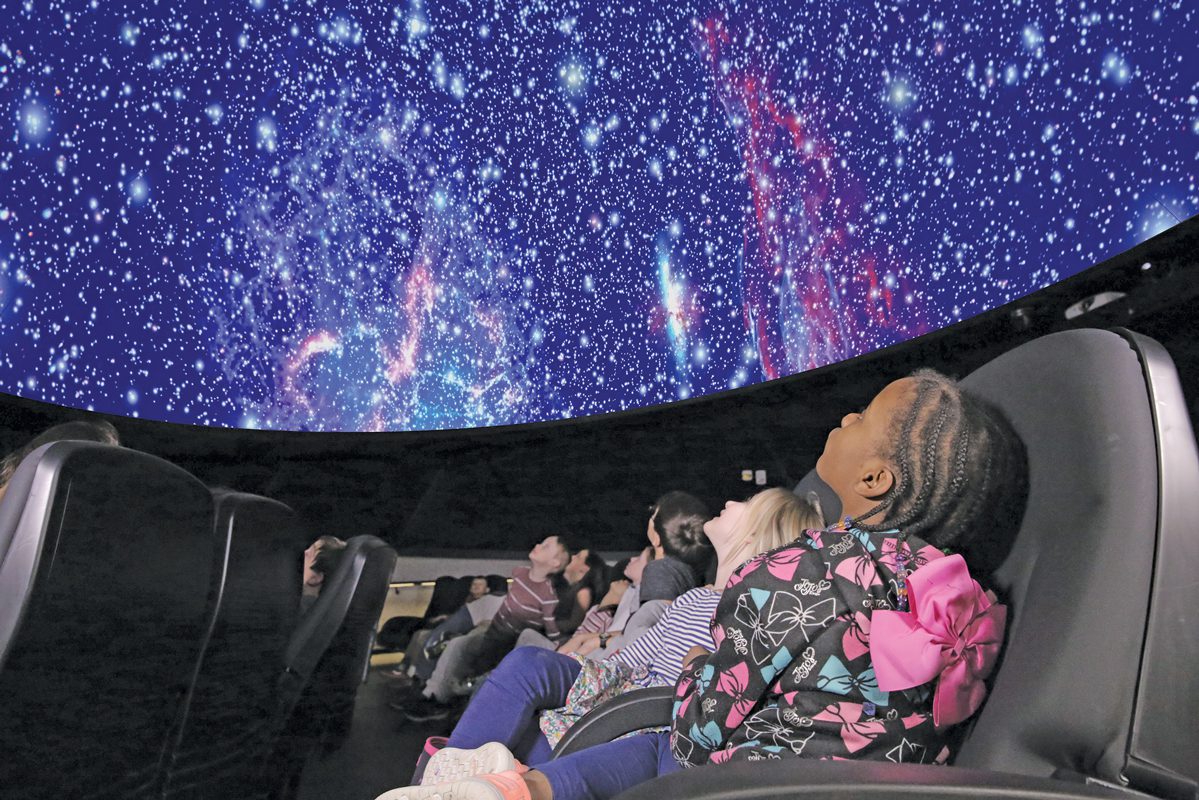
Inside the U-M Museum of Natural History Planetarium & Dome Theater. | Courtesy of the U-M Museum of Natural History
If you find that contemplating the vastness of the universe helps you put the craziness of a single primate species on one little planet into perspective, sometimes it helps just to look at the stars. You can try to peer at the night sky through local light pollution, you can drive at least an hour to one of Michigan’s “dark sky” parks for a clearer view of the cosmos—or you can visit the U-M Museum of Natural History Planetarium & Dome Theater. It will give you pointers to deepen and inform your next outdoor stargazing session, but more to the point, it will put you in a reflective and perhaps reverential space with fellow sky-worshipers for 45 minutes. Not a bad place to be on a cold winter day.
The planetarium rotates three shows every month, but the Sky Tonight, which runs twice every Friday, Saturday, and Sunday, is always the “star” attraction. The presenter, usually a U-M science student, leads an exploration of the current night sky, gives tips on how to find the cardinal directions, constellations, and planets on your own, and winds up with a trippy full-speed-ahead jaunt through the stars that feels both like a roller coaster and a ride on a spaceship.
The other shows are science-related movies made for dome theaters. We Are Stars uses the somewhat awkward conceit of a carnival sideshow to describe the cosmic chemistry of the big bang, connecting life on Earth to the evolution of the universe—a giddying thought-journey that’s sure to put things in perspective.
Sea Monster has nothing to do with stars at all. As the university’s listing explains, it follows a “dolichorhynchops—familiarly known as a ‘dolly’—as she travels through the most dangerous oceans in history” during the Late Cretaceous era. The film does a good job of using the immersive screen to put the viewer into ancient oceans, as well as to depict the passage of millions of years on the planet’s surface. The thankfully short tie-ins to archaeology seemed to lose the youngest viewers on the day I visited, but I was pleased to have the bones connected to conjectures about how the animals lived—and then step into the museum to look at ancient marine mammal and reptile fossils myself.
The day I went to see the Sea Monster, the host was David Cooper, a U-M junior majoring in chemistry. He credits both his visits to the Abrams Planetarium in East Lansing and the work of popular astrophysicist Neil DeGrasse Tyson with sparking his excitement about astronomy and science as a child, and calls working here “the best job I’ve ever had.”
If you have small children, check the recommended ages for each show before buying tickets at the gift shop, but honestly, the entire museum is a wealth of indoor distractions for all ages. It offers immersive exhibits about—and shows off the bones of—dinosaurs and other animals, as well as geology, evolution, microorganisms, scientific process, the natural world of Michigan, and more. The museum has enough wow-factor to turn even the most STEM-averse child into a future scientist, or at least a more science-literate citizen.
As I walked toward the planetarium on a snowy day, a student was dissecting a cow eye—to the disgust and curiosity of a group of parents and children—as part of the museum’s regular “Discovery Demos.” I then passed the engaging exhibit that demonstrates relative scale in the universe; it reminded me of how huge I am (compared to a proton)—and how small (compared to a galaxy).
The UMMNH Planetarium & Dome Theater operates every Fri.–Sun., as well as some holidays, and each show costs $8 in the gift shop. The museum itself is, astonishingly, free, but donations are encouraged. Although it’s far smaller than the Chicago Field Museum, it’s full of imaginative and involving exhibits, and well worth the trip, especially if you have a future scientist in your life, want to become more science-literate yourself, or just like tapping into your childlike sense of awe.